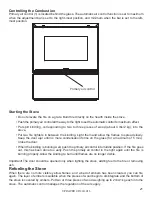
6
UPDATED 09/20/2013
chimneys in the standard for Chimneys, Factory-Built, Residential Type and Building Heating Appliance,
UL 103, or 2) a code-approved masonry chimney with a fl ue liner.
For any unresolved questions about installation in the USA, refer to the national Fire Protection
Association’s publication ANSI/NFPA 211 Standard for Chimneys, Fireplaces, Vents and Solid Fuel
Burning Appliances. For installation in Canada, refer to CSA CAN-B365, Installation Code for Solid Fuel
Burning Applications and Equipment. These standards are the basis for many national codes. They are
nationally recognized and are accepted by most local authorities. Your local dealer or your local building
offi cial may have a copy of these regulations.
WARNING
!
CHECK ALL LOCAL BUILDING AND SAFETY CODES BEFORE INSTALLATION. THE
INSTALLATION INSTRUCTIONS AND APPROPRIATE CODE REQUIREMENTS MUST BE
FOLLOWED EXACTLY AND WITHOUT COMPROMISE. ALTERATIONS TO THE STOVE ARE
NOT ALLOWED. DO NOT CONNECT THE STOVE TO A CHIMNEY SYSTEM SERVING ANOTHER
STOVE, APPLIANCE OR ANY AIR DISTRIBUTION DUCT. FAILURE TO FOLLOW THESE
INSTRUCTIONS WILL VOID THE MANUFACTURERS WARRANTY.
NOTE
If you plan to vent your stove into an existing masonry chimney, have the chimney inspected by a
local fi re marshal or qualifi ed installer. Remember that the chimney and its location on the roof heavily
infl uences the stoves performance. An oversized fl ue may not provide effective draft and a fl ue liner
may be required. (Observe draft requirements). Consult your dealer or qualifi ed installer before fi nal
selection is made.
We advise you to leave enough room to enable cleaning between the stove and the wall.
Clearance to combustibles
One of the main necessary precautions you must take, when installing a stove is to leave suffi cient
space between the stove (top, sides, back, front, and under stove pipes) and any material that can
catch fi re.
Содержание 04201
Страница 33: ...33 UPDATED 09 20 2013 ...







































